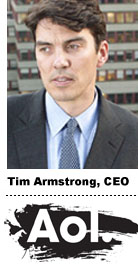 While AOL’s Q3 growth was surely a welcome sign to patient investors, the fact that it has continued to come from its third party network and search ad deal with Google could be a long term problem. During a call with analysts, CEO Tim Armstrong acknowledged several times that the “traditional” display model of ad networks supported by direct response marketers would be shrinking. (Read the earnings release.)
While AOL’s Q3 growth was surely a welcome sign to patient investors, the fact that it has continued to come from its third party network and search ad deal with Google could be a long term problem. During a call with analysts, CEO Tim Armstrong acknowledged several times that the “traditional” display model of ad networks supported by direct response marketers would be shrinking. (Read the earnings release.)
Instead, Armstrong sought to convince analysts that a combination of premium ad sales on AOL’s owned-and-operated properties with more use of targeted ads through programmatic buying would help solidify the company’s revenue gains in the short term and offset the shrinkage of the traditional display ad net model over the long term.
Here’s a quick rundown of AOL’s Q3:
- U.S. display revenue slipped 3 percent as international, after years of rebuilding, jumped 18 percent
- Global ad dollars grew 7 percent as total revenues were flat for what the company says was its best performance in seven years, thanks in part to the inclusion of dollars from the joint venture, AOL Japan.
- Third party network revenues — primarily from Advertising.com — shot up 18 percent; combined with revenue from AOL’s O&O sites, the gain was only 7 percent, suggesting that premium direct sales and Project Devil ad units, despite double-digit growth, continue to lag and will take time to become meaningful to the overall business. Spending on AOL’s own properties was up a mere 2 percent. Ad.com revenues, specifically, grew 8 percent.
- Search and contextual revenues rose 8 percent, the first time that segment has seen growth in three years.
In a research note released just after AOL’s Q3 results, Jefferies & Co. analyst Brian Pitz pointed out that AOL’s performance exceeded his own and analysts’ general expectations. During the Q&A, after Armstrong noted the big bets he’s been making on premium ad revenue from AOL’s video properties, particularly HuffPost Live and its AOL On Network coming from record political ad spending, Pitz asked Armstrong how he expected to keep the momentum going over the next few quarters.
“Well, I was just talking about this with Arianna [Huffington],” Armstrong said, referring to the HuffPo Media President, “and if there was a tie in today’s presidential election, that would certainly help.” Half-jokes aside, Armstrong pointed to being able to generate between $5 and $10 million alone from its syndicated video properties.
“In terms of 2013, we are seeing much stronger trends on the display side, as we are much more focused around fewer things and we’re seeing a major shift of TV ad dollars moving online, which is something we’re well positioned to take advantage of,” Armstrong said, outlining his general vision of where he sees the domestic display market headed.
Above all, he pointed to momentum around programmatic buying and marketing services as other areas that AOL expects to do well, thanks to the technology stack the company has put in place over the years and the continued scale by dint of the 111 million unique visitors to AOL Properties in Q3, which represented a 4 percent rise year-over-year.
Armstrong was also asked about what he’s hearing from advertisers. He said programmatic buying is looming larger.
“Basically, companies … have a need to do higher-scale projects, such as programmatic buying and targeting, on one side,” Armstrong said. “All the agencies and holding companies are focused around that. There’s a trend toward offering more formats within programmatic, and video and mobile are two areas where we think can really move that needle. By the end of next year, the major trend in display advertising will be to take those multiple formats within a programmatic setting and price them, target them and measure them all on the same system. That’s something we can do now and it’s something that will influence advertising in general more and more in the years to come with programmatic budgets comprising at least 28- to 30-, even 40 percent.”
Currently, Armstrong estimates that AOL’s largest advertisers — he did not specify which — spend roughly 10 to 20 percent of their budgets on programmatic, though he did concede that most do not spend that much.
In addition to mobile and video advertising, which despite rapid growth remains a fraction of the overall online ad sales pie, AOL is also trying to figure out social. Armstrong said that having share-worthy content is key to social success and he said that the company has been forming partnerships to take advantage of social platforms.
Despite the fact that Google and Facebook are battling it out for the dominant role in the display space, just like AOL makes money off its Google relationship, it’s not all competition. There could be possibilities for AOL to leverage Facebook, especially through AOL’s third party network, though Armstrong made no mention of working with Facebook.
For the moment, Armstrong hinted that there would be more work with Google to come, possibly with the search giant’s paid product listing ad platform.
“Our relationship with Google is that we jointly test products and services,” Armstrong said. “We just met with them last week. You should expect us to adopt more of their offerings.”









